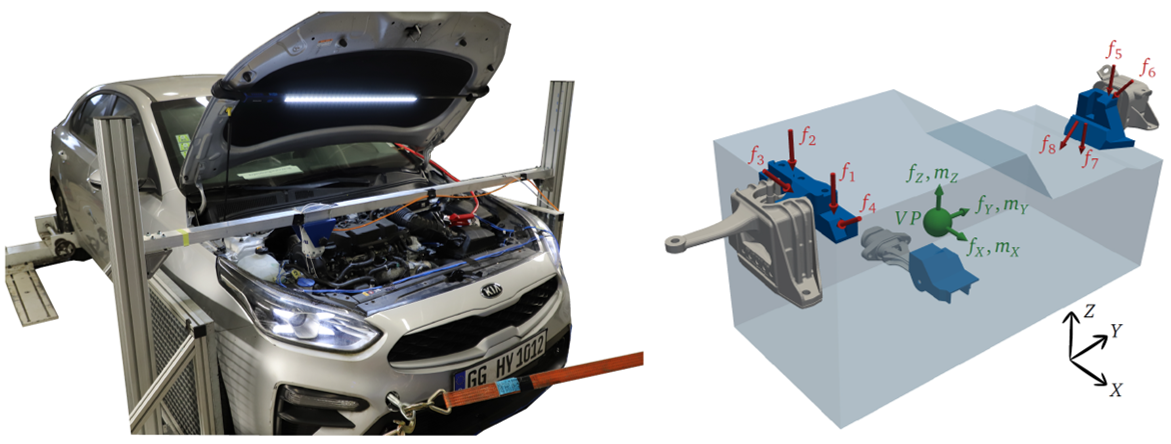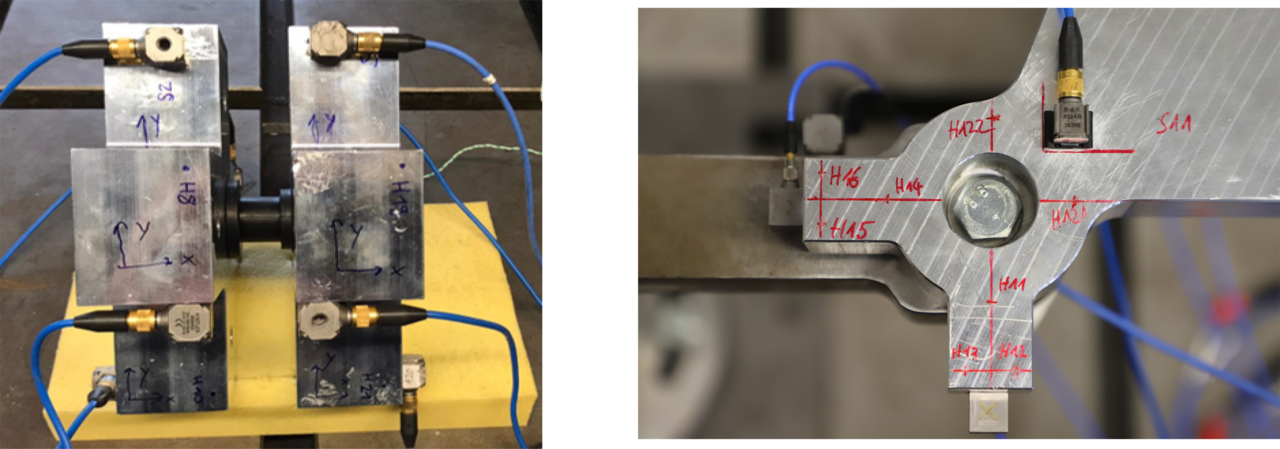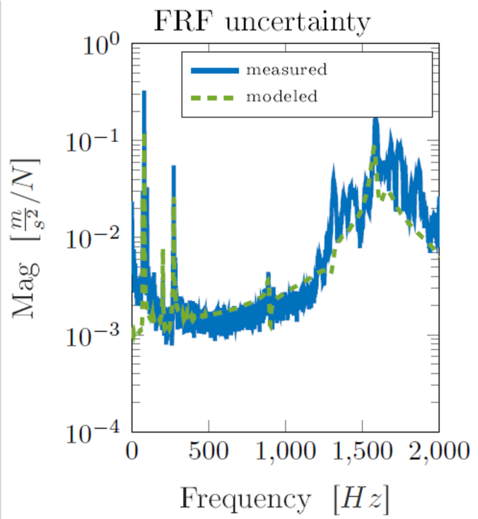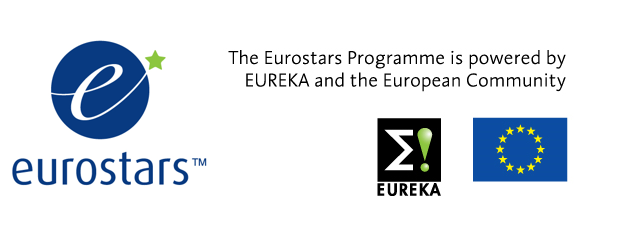- Experimental twelve degree of freedom rubber isolator models for use in substructuring assemblies. Journal of Sound and Vibration 474, 2020, 115253 more… BibTeX Full text ( DOI ) Full text (mediaTUM)
- Comparison of Different Approaches to Include Connection Elements into Frequency-Based Substructuring. Experimental Techniques, 2020 more… BibTeX Full text ( DOI ) Full text (mediaTUM)
- Experimental Joint Identification Using System Equivalent Model Mixing in a Bladed Disk. Journal of Vibration and Acoustics 142 (5), 2020 more… BibTeX Full text ( DOI ) Full text (mediaTUM)
- A practical handling of measurement uncertainties in frequency based substructuring. Mechanical Systems and Signal Processing 144, 2020, 106846 more… BibTeX Full text ( DOI ) Full text (mediaTUM)
Dynamic Substructuring & Transfer Path Analysis
The concept of dynamic substructuring (DS) is to analyze the structural dynamics of a system component by component. This allows the analysis of large and complex structures and also offers the possibility to combine modeled parts and experimentally identified components. This is particularly useful for components that are very difficult to model correctly. In addition, several methods have been developed to determine critical paths for sound and vibration transfer, also known as transfer path analysis (TPA). Current research includes the improvement and validation of DS and TPA methods, which opens up interesting possibilities for the early development phase of Noise, Vibration and Harshness (NVH).

Joint dynamics
To characterize the dynamic property of an interface between components, there are several techniques in experimental practice. In addition to the use of standardized methods and tests to acquire interface characteristics, the DS and TPA concepts mentioned above can be used. If these methods can be used to determine the properties of interfaces, then they can also be used to determine the properties of connection elements acting on that interface. Typical applications include bolted joints and rubber mounts. The challenges in this area relate to measurement uncertainty and the occurrence of nonlinear effects at the joints. Both can hinder the application of interface models in real engineering problems. Ultimately, the identified interface parameters can be used either as a basis for modeling techniques or for modeling joints.

Uncertainty quantification & regularization

Proper measurement data acquisition is a prerequisite for successful performance of experimental substructuring procedures. In this context, the investigation of measurement uncertainties is of particular interest due to the precision standard required in industrial practice. This is because quality, cost and risk assessments are directly related to the reliability of experimental prediction. With respect to random measurement uncertainty, strategies in the frequency and state space domains are currently under investigation. To limit the propagation/amplification of uncertainty in common dynamic substructuring algorithms, mathematical tools such as regularization techniques are often used.
The goal of the project is to develop methodologies and algorithms for the COUPLE software in collaboration with Dutch SME Vibes Technology B.V. and the BMW Group. COUPLE uses frequency-based substructuring to determine how actively vibrating components transfer energy through damping elements (rubber bushings) to passive components to reach the target (e.g., driver's ear). Frequency-based substructuring divides an assembly into substructures, which are then modeled separately. The models of these substructures are combined using force and displacement equilibrium constraints to predict the response of the overall system.
When using substructuring, the individual components can be modeled using two approaches: computational and test-based. The computer-based modeling is relatively simple, but its results are not good enough to be used in real practical applications. Test-based modeling (used by COUPLE in combination with computational modeling) is much more accurate, but there are major technical challenges to apply it to complicated structures in practice. In the last decade, test-based substructuring has mostly been performed in academic settings on simple structures, in well-controlled environments, and with a validation measurement as a reference. These studies have demonstrated the enormous potential of test-based modeling. The next step is to work with industry partners to bring the method to the maturity required by industry.
The goal is to offer practical, robust and reliable finite element models for two types of connection elements, namely bolted connections and rubber mountings, in order to predict the vibrational behaviour of the system for different contact types and characteristics. For the rubber the focus is more on the constitutive modeling of the material, while for the bolted connection the contact itself represents the critical element. In both cases, the complexity lies in modelling the non-linear behaviour and parameter dependencies that characterise the connection under certain operating conditions. The modeling approaches range from a white box to a black box description, on the basis of the experimental tuning required to describe the dynamic behaviour of the joint. The former implies a full understanding and predictivity of the multi-scale and multi-physics phenomena underlying the joint dynamics. The latter indicates the knowledge of the only input/output dynamic representation of the connection element. In any case, it is required both a strategy for the characterization of the joint parameters and a practical and efficient implementation of the associated models in classic finite element codes.
In the automotive industry, Noise, Vibration, and Harshness (NVH) is becoming increasingly important to meet customer expectations for acoustic performance. To this end, methods are being developed to predict and improve NVH problems. One broad group of diagnostic tools for analyzing noise and vibration is transfer path analysis (TPA). Theoretically, it should be possible to characterize vibrations from active (source) and passive (receiver) structures independently. This will allow prediction of structure-borne noise for a structure with an excitation source (e.g., engine-transmission unit) on any coupled receiver structure (e.g., car body including rubber mounts). Within the scope of this project, existing methods for the characterization of the active structure shall be further developed. Furthermore, the assumption of unchanged excitations in different test rigs shall be investigated to allow the transferability of equivalent forces. A method that eliminates the contribution of non-measurable operating forces in the measured signals is called the Operational System Identification (OSI) method. This should be further developed to provide a reference excitation signal that is measurable. Combine this with the in-situ blocked force TPA approach, and this may lead to a promising measurement method that allows rubber bearings to be kept in a specific operating condition. In addition, methods for characterizing rubber bearings are to be further developed. Here, the dependent factors such as static preload, temperature, frequency and amplitude will be investigated in more detail. A major challenge can be the nonlinear behavior of rubber bearings. An investigation of how nonlinear effects of rubber bearings can be integrated into the FBS method is therefore also planned.
Project partner
This project is supported in part by Hyundai Motor Company (HMC) including its subsidiary Kia Motors Coroperation - 12, Heolleung-ro, Seocho-gu, Seoul, 06797, Korea.
The continuous development of experimental techniques in the field of dynamic substructuring and vibration analysis requires extensive investigation and experimental research. In addition to the efforts made for measurement campaigns, experimental setup, and experimental acquisitions, appropriate post-processing of the acquired data is necessary to improve the quality and reliability of experimental substructuring predictions. Uncertainty quantification, regularization, noise filtering, and data selection are some of the topics addressed in this research project. Here, current scientific and industrial challenges will be investigated in more detail. The goal is to develop a deep understanding of the errors that affect substructuring results and ultimately provide practical and robust strategies and tools for improved handling of experimental data.
Coupling test-based and computer-based models to predict critical NVH problems in automobiles. (Estars2 #114266)
Besides the Chair of Applied Mechanics, two project partners are involved in the realization of the project. The R&D operating SME Vibes Technology B.V., focuses on the software development of COUPLE. The BMW Group provides industrial test applications to validate the functionality of the software and the methodology using real vehicle components in an industrial environment.
Acknowledgement
This project is supported by EUREKA and the European Union within the Eurostars program.

Modeling connections in vibration analysis (BMW Motorrad)
To support the Chair of Applied Mechanics in the research and development of connection elements, BMW Motorrad provides test facilities and real motorcycle application cases. This allows a direct implementation of the most advanced technologies and bridges the gap between academia and industry.
Acknowledgement
This project is supported by BMW Motorrad.

2020
2019
- Design optimization of joint parameters using Frequency Based Substructuring. PAMM 19 (1), 2019 more… BibTeX Full text ( DOI ) Full text (mediaTUM)
- Combining Blocked Force Transfer Path Analysis And Dynamic Substructuring For Acoustic Design Optimization. Proceedings of ICEDyn 2019-International Conference on Structural Engineering Dynamics, Ericeira, Portugal, 3-5 July 2017, 2019 more… BibTeX Full text (mediaTUM)
- Development of a Low Cost Automatic Modal Hammer for Applications in Substructuring. In: Conference Proceedings of the Society for Experimental Mechanics Series. Springer International Publishing, 2019 more… BibTeX Full text ( DOI ) Full text (mediaTUM)
- Using Laser Vibrometry for Precise FRF Measurements in Experimental Substructuring. In: Conference Proceedings of the Society for Experimental Mechanics Series. Springer International Publishing, 2019 more… BibTeX Full text ( DOI ) Full text (mediaTUM)
2018
- Comparison of substructuring techniques for experimental identification of rubber isolators dynamic properties. Proceedings of ISMA2018 including USD2018, 2018 more… BibTeX Full text (mediaTUM)
- Automated Correction of Sensor Orientation in Experimental Dynamic Substructuring. Dynamics of Coupled Structures, Volume 4: Proceedings of the 36th IMAC, A Conference and Exposition on Structural Dynamics 2018 (Conference ... Society for Experimental Mechanics Series), Springer, 2018 more… BibTeX Full text (mediaTUM)
2017
- Post Correcting for Gyroscopic Effects via Dynamic Substructuring. 24th International Congress on Sound and Vibration (ICSV), 2017 more… BibTeX Full text (mediaTUM)
- Optimal transformation of frequency response functions on interface deformation modes. IMAC XXXV - International Modal Analysis Conference, 2017 more… BibTeX Full text (mediaTUM)